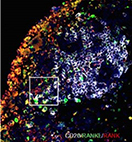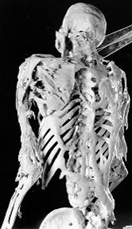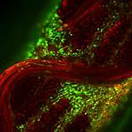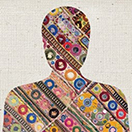SPOTLIGHT
Letter from Dr. Stephen I. Katz: NIH Support for High-Risk, Innovative Research
Dear Colleagues,
Biomedical researchers are driven by imagination, curiosity and the excitement that comes with every new insight into how organisms function or new strategy that improves people's lives. These findings build upon one another, expanding the knowledge base from which future studies emerge. Every so often, a particularly innovative set of experiments dramatically changes how we conduct research, interpret results, care for patients or prevent disease.
Image: Stephen I. Katz, M.D., Ph.D.
NEWS
Immune Cell's Role in Rheumatoid Arthritis-Induced Bone Loss Revealed
A study, supported in part by the NIAMS, has revealed how B cells—a specialized type of immune cell—contribute to the bone loss that occurs in patients with rheumatoid arthritis (RA). The research suggests new pathways to target in developing treatments for preserving bone in people with RA.
Image: Joint tissue from patients with rheumatoid arthritis contains high numbers of B cells (white) that produce high levels of RANKL (green) and stimulate osteoclasts (red). Photo credit: Jennifer H. Anolik, M.D., Ph.D., University of Rochester.
New Insights About Excess Bone Formation in Rare Disease Lead to Potential Drug Treatments
Two studies on fibrodysplasia ossificans progressiva (FOP), a rare genetic disorder that causes excess bone to form, have contributed to our understanding of how the disease progresses. These studies, funded in part by the NIAMS, have also identified promising treatment options.
Image: Harry Eastlack, who had FOP, bequeathed his skeleton to medical science. Photo credit: Frederick Kaplan, M.D., University of Pennsylvania.
Readily Available Pain Medication a Cost-Effective Choice for Many Older Adults With Knee Osteoarthritis
Naproxen or ibuprofen—obtained over the counter or by prescription—provide more benefit for older adults who have knee osteoarthritis (OA) plus co-existing conditions compared to more expensive, prescription-only pain medications, according to a study funded by the NIAMS.
Researchers Discover Otulipenia, a New Inflammatory Disease: Rare and Sometimes Lethal Disease Affects Young Children
Researchers from the NIAMS; the National Human Genome Research Institute (NHGRI); the National Institute of Allergy and Infectious Diseases (NIAID); the National Heart, Lung, and Blood Institute (NHLBI); and the NIH Clinical Center have discovered a rare and sometimes lethal inflammatory disease—otulipenia—that primarily affects young children. They have also identified anti-inflammatory treatments that ease some of the patients' symptoms, including fever, skin rashes, diarrhea, joint pain and overall failure to grow or thrive.
Image: Otulipenia is a rare and sometimes lethal inflammatory disease that causes fever, skin rashes, diarrhea and joint pain in young children.
Approach Targets Autoimmunity
In a study funded in part by the NIAMS, researchers developed a strategy to treat a rare autoimmune disease called pemphigus vulgaris and demonstrated its potential in a mouse model. The strategy is based on a technology that combats cancer by modifying a patient's T cells to target a specific protein.
Image: A colorized scanning electron micrograph of a T cell. Photo credit: NIAID.
Stem Cells Grown on Scaffold Mimic Hip Joint Cartilage
In research supported in part by the NIAMS, scientists applied new techniques for growing stem cells on a 3-D scaffold to mimic a hip joint surface. Their results may lead to new approaches for treating joint surfaces damaged by osteoarthritis or injury.
Image: Stem cells (stained green) grew throughout the pores of the scaffold (stained red). Photo credit: Farshid Guilak, Ph.D., Washington University.
Bioengineers Grow Living Bone for Facial Reconstruction: Integration of Engineered Cells With Natural Bone Matrix Showed Critical Advances in a Pig Model Study
In this study, supported in part by the National Institute of Biomedical Imaging and Bioengineering (NIBIB), researchers grafted customized implants into pig jaws that resulted in integration and function of the engineered graft into the recipient's own tissue.
Image: Engineered jaw bone is transplanted to pigs. The engineered bone is cultivated from the pig's own stem cells seeded on a scaffold of cow-bone matrix.
Skin Conditions and Complementary Health Approaches
The National Center for Complementary and Integrative Health (NCCIH) highlights the most recent scientific evidence regarding complementary health approaches for skin conditions, including atopic dermatitis, psoriasis, acne, impetigo and rosacea.
Mercury Poisoning Linked to Skin Products
The U.S. Food and Drug Administration (FDA) cautions that you should avoid skin creams, soaps and lotions that contain mercury. If the label includes any of these words—mercurous chloride, calomel, mercuric, mercurio or mercury—then the product contains mercury, and you should stop using it.
Outsmarting Poison Ivy and Other Poisonous Plants
Poison ivy and other poisonous plants are a hazard all year round. The FDA has some tips for preventing and treating the itchy rash and blisters. Watch the video for more information.
RESOURCES
Spotlight on Scientific Imagery: Stem Cells Engineered to Grow Cartilage

A three-dimensional, biodegradable, synthetic scaffold was molded into the precise shape of a hip joint. The scaffold was covered with cartilage made from stem cells taken from fat beneath the skin. The stem cells were seeded onto the scaffold and coaxed into turning into cartilage cells, using a cocktail of growth factors. The stem cells regenerated cartilage throughout the woven scaffold, while the scaffold slowly dissolved. The newly formed cartilage can be used to completely resurface an arthritic joint. The engineered cartilage also releases anti-inflammatory molecules to keep arthritis at bay. This process may lead to treatments for hip osteoarthritis that avoid the need for extensive hip replacement surgery. This image is courtesy of Farshid Guilak, Ph.D., of Washington University.
Watch Rare Disease Patient Profiles from 2016 Rare Disease Day Event—Videos
The National Center for Advancing Translational Sciences (NCATS) recently released a new video series to help raise awareness about rare diseases and the hope offered through collaborative research. Watch Joe Murray discuss his daughter's experience with epidermolysis bullosa, a disease that causes the skin to be so fragile that even the slightest friction can cause open blisters, wounds and chronic pain. In addition, Marcela Ferrada shares her story of living with an autoimmune disease called relapsing polychondritis.
Featuring NIAMS' Bilingual Fotonovelas on Sports Injuries and Bone Health
Learn about healthy bones and muscles with these two easy-to-read bilingual (English/Spanish) fotonovelas. Ana's Story: How She and Her Family Learned About Sports Injuries, is available in both Spanish and English. Isabel's Story: How She and Her Family Learned About Osteoporosis and Bone Health, is also available in both Spanish and English. Order copies using the NIAMS catalog (Spanish or English) and share these useful resources widely.
EVENTS
September 13 NIAMS Advisory Council Archived Videocast Now Available
The September 13 NIAMS Advisory Council archived videocast is now available in the Past Events section of the NIH Videocasting website.

18th Annual Small Business Innovation Research and Small Business Technology Transfer Conference
November 15–17, 2016
Orlando, Florida 32821
View agenda.
Registration is available.
NIH Science Lectures and Events Available via Internet
The NIH hosts a number of science seminars and events that are available online through real-time streaming video (videocast). The NIH calendar notes these videocast events with a video icon ![]() .
.
Funding Announcements
If you would like information about funding opportunities, please view the NIH Guide for Grants and Contracts, the primary source for information about NIH funding opportunities. You can also request a weekly Table of Contents from the NIH Guide. In addition, the NIAMS website provides comprehensive information on NIAMS-related grants and processes.













